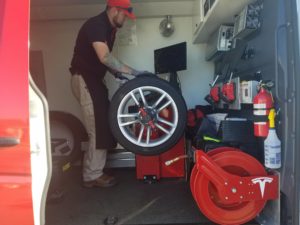Efficient Flat Tire Repair Las Vegas - Mobile Support
Efficient Flat Tire Repair Las Vegas - Mobile Support
Blog Article
Tire Service: Proven Techniques for Optimum Tire Maintenance and Care
From guaranteeing appropriate tire pressure to regular turning and positioning, there are tested techniques that can dramatically prolong the life expectancy of your tires and boost total driving experience. Let's delve right into the globe of tire service and discover the secrets to keeping your tires in excellent shape for the long haul - Mobile Tire Service Las Vegas.
Value of Tire Stress
Proper tire stress is a critical factor in making sure optimum automobile performance and safety and security on the road. Preserving the advised tire stress degrees given by the manufacturer provides various benefits. First of all, appropriate tire stress advertises much better gas performance, as under-inflated tires can lead to enhanced rolling resistance, triggering the engine to function more difficult and take in even more gas. Right tire stress makes certain even tread wear, enhancing tire durability and saving money in the long run by delaying the requirement for early replacements. Furthermore, effectively inflated tires add to boosted handling and stopping capacities, vital for risk-free driving in numerous road conditions. Over-inflated tires, on the other hand, can result in decreased grip and a harsher experience. On the other hand, under-inflated tires are susceptible to getting too hot, which can bring about blowouts and accidents. Frequently changing and inspecting tire pressure, specifically previously long journeys, is a straightforward yet efficient way to enhance lorry efficiency, expand tire life expectancy, and focus on security when traveling.
Tire Rotation Guidelines
When taking into consideration tire turning standards, it is important to comprehend the relevance of this maintenance task in optimizing tire lifespan and keeping ideal vehicle performance. Tire turning entails altering the position of each tire on an automobile to ensure even walk wear. Front tires tend to use quicker than rear tires because of guiding pressures, making routine turning vital for balanced wear patterns. The recommended turning pattern varies relying on whether a vehicle is front-wheel, rear-wheel, all-wheel, or four-wheel drive. Commonly, tires ought to be turned every 5,000 to 7,500 miles, or as suggested in the vehicle manual. Overlooking tire rotation can bring about unequal wear, influencing handling, traction, and potentially compromising car security. By sticking to correct turning standards, vehicle drivers can expand the life of their tires, improve fuel effectiveness, and improve total driving experience. Regular rotation is a simple yet reliable upkeep method that contributes substantially to tire durability and car efficiency.

Advantages of Wheel Alignment
Making certain correct wheel placement after tire rotation is vital for preserving balanced wear patterns and maximizing car efficiency. Furthermore, right wheel placement assists to extend the life expectancy of your tires. Misaligned wheels can cause unequal tire wear, leading to premature tire substitute and boosted maintenance prices.

Tire Tread Deepness Check
Doing a routine examination of tire walk depth is essential for preserving safe driving conditions and prolonging the life-span of your tires. The tread on your tires plays a crucial role in offering grip, especially in slippery or damp problems. To check your tire tread deepness, you can make use of a walk deepness scale or the cent examination. The recommended company website walk deepness is at the very least 2/32 of an inch. It is time to change your tires to ensure ideal efficiency and safety and security on the road if the walk deepness is listed below this limit. Uneven tread wear can suggest issues with tire stress, suspension, or alignment, highlighting the importance of normal walk deepness checks. Ignoring to keep track of and maintain appropriate step deepness can lead to minimized grasp, longer braking ranges, and a raised danger of hydroplaning. By integrating tire step depth check out your routine maintenance schedule, you can drive with confidence understanding that your tires remain in leading condition.
Seasonal Tire Examination
Seasonal tire assessment is a basic element of tire maintenance that guarantees tires are ready to encounter the obstacles presented by different weather problems. In prep work for winter season, it is important to check the tire stress consistently as cool temperatures can cause tire stress to go down. By conducting regular seasonal tire assessments, motorists can prolong tire life-span, improve fuel performance, and most significantly, ensure a safe and secure driving experience in differing weather problems.
Final Thought
In conclusion, keeping appropriate tire stress, turning tires frequently, aligning wheels appropriately, checking walk depth, and conducting seasonal assessments are important practices for ideal tire care. By following these confirmed techniques, drivers can guarantee their tires last longer, execute far better, and add to total automobile safety. It is essential to focus on tire maintenance to stop crashes, boost fuel efficiency, and extend the more info here life-span of tires.
Appropriate tire pressure promotes better gas efficiency, as under-inflated tires can lead to raised rolling resistance, triggering the engine to function more difficult and eat more gas.When thinking about tire rotation standards, it is important to recognize the importance of this maintenance task in making the most of tire life-span and keeping optimal car efficiency. Seasonal tire examination is a fundamental aspect of tire maintenance that makes sure tires are all set to encounter the obstacles postured by various weather conditions. By conducting routine seasonal tire assessments, vehicle drivers can prolong tire lifespan, enhance fuel effectiveness, and most significantly, make sure a safe and secure driving experience in varying weather conditions.
In final thought, keeping correct tire pressure, rotating tires regularly, aligning wheels properly, checking step deepness, and performing seasonal assessments are necessary techniques for ideal tire care.
Report this page